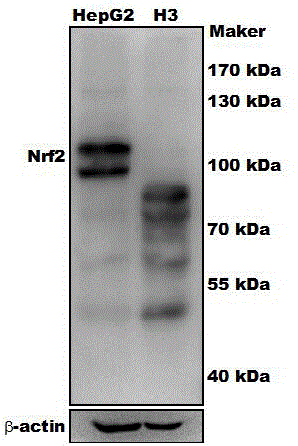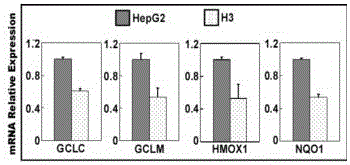sgRNA and vector pair for orientated knockout of nrf2 gene in human hepatocyte and application
A gene knockout, hepatocyte technology, applied in the direction of DNA/RNA fragments, introduction of foreign genetic material, vectors, etc. using vectors, can solve the problem of poor stability and repeatability of siRNA technology, can not completely eliminate Nrf2 protein, cannot exclude Nrf2 protein and other problems, to achieve the effect of excellent gene editing effect, stable morphology, and simple and easy research.
- Summary
- Abstract
- Description
- Claims
- Application Information
AI Technical Summary
Problems solved by technology
Method used
Image
Examples
Embodiment 1
[0030] Example 1 Selection of editing sites and design and construction of Nrf2-CAS9 plasmid
[0031] According to the gene editing principle of CAS9 technology, two CDS regions in the Nrf2 genome were selected as the Nrf2 gene CAS9 targeted editing sites. The No. 1 recognition sequence is: 5'-tatttgacttcagtcagcga-3' (SEQ ID NO.1), and the No. 2 recognition sequence The sequence is: 5'-gttgatttagacggtatgca-3' (SEQ ID NO. 2).
[0032] According to the selected target editing site, the sgRNA sequence is designed, and the sgRNA is composed of sgRNA1 that specifically recognizes the Nrf2 gene and sgRNA2 that specifically recognizes the Nrf2 gene. The sequence of the sgRNA1 is shown in SEQ ID NO. The font part is the gRNA backbone sequence), and the sequence of sgRNA2 is shown in SEQ ID NO.4 (gttgatttagacggtatgcagttttagagctagaaatagcaagttaaaataaggctagtccgttatcaacttgaaaaagtggcaccgagtcggtgcttt, the bold font part is the gRNA backbone sequence).
[0033] Design Nrf2 knockout site PCR ...
Embodiment 2
[0038] Example 2 Screening, cultivation and identification of monoclonal cell lines knocked out of Nrf2 gene
[0039] 1) Nrf2-CAS9 plasmid transfected HepG2 cells:
[0040] a. HepG2 cells were planted in 2 wells of a six-well plate, which were respectively recorded as A (plasmid transfection group) and B well (control group), with 300,000 cells per well, and cultured overnight in DMEM medium. After the cells grow at the bottom of the well plate to cover about 80% of the bottom plate, prepare to transfect the Nrf2-CAS9 plasmid.
[0041] b. Aspirate the DMEM medium in wells A and B, and add 800 μL Opti-MEM.
[0042] c. Prepare solution 1, solution 2 and solution 3; among them, the formula of solution 1 is as follows: take 1.5 μg of Nrf2-CAS9-1 plasmid and 1.5 μg of Nrf2-CAS9-2 plasmid, add 100 μL Opti-MEM, mix and let stand for 5 minutes;
[0043] Solution 2: 100 μL Opti-MEM;
[0044] Solution 3: Take 18 μL of lipo2000 and add 200 μL Opti-MEM, mix well and let stand for 5 min...
PUM
 Login to View More
Login to View More Abstract
Description
Claims
Application Information
 Login to View More
Login to View More - R&D
- Intellectual Property
- Life Sciences
- Materials
- Tech Scout
- Unparalleled Data Quality
- Higher Quality Content
- 60% Fewer Hallucinations
Browse by: Latest US Patents, China's latest patents, Technical Efficacy Thesaurus, Application Domain, Technology Topic, Popular Technical Reports.
© 2025 PatSnap. All rights reserved.Legal|Privacy policy|Modern Slavery Act Transparency Statement|Sitemap|About US| Contact US: help@patsnap.com


